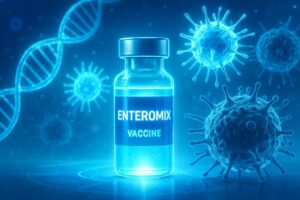
Elderly couple after getting vaccines for people 60 and older
Wondering which shots matter after 60? Learn the six essential vaccines for people 60 and older, who should get them, when to schedule, and side effects.
The Most Essential Vaccines for People 60 and Older
As we get older, our immune system slows down. Illnesses hit harder, and recovery takes longer. The good news? Vaccines help. They lower your risk of severe disease, hospital stays, and long-term complications. Below you’ll find the six most important vaccines for people 60 and older, plus when to get them, what to expect, and how to plan your schedule.
Note: Guidance evolves as new data arrives. Always check the latest recommendations where you live and talk with your clinician about your personal risks. For reference, this guide cites current CDC/ACIP recommendations (United States) and other expert sources as of September 2025. CDC
Why vaccines for people 60 and older matter
Older adults face higher rates of lung infections, shingles complications, and pneumonia. Vaccines reduce those risks. They also help keep chronic conditions—like heart or lung disease—from spiraling during an infection. In short, shots protect you and ease the load on your body. CIDRAP
1) Flu (Influenza): yearly protection that pays off
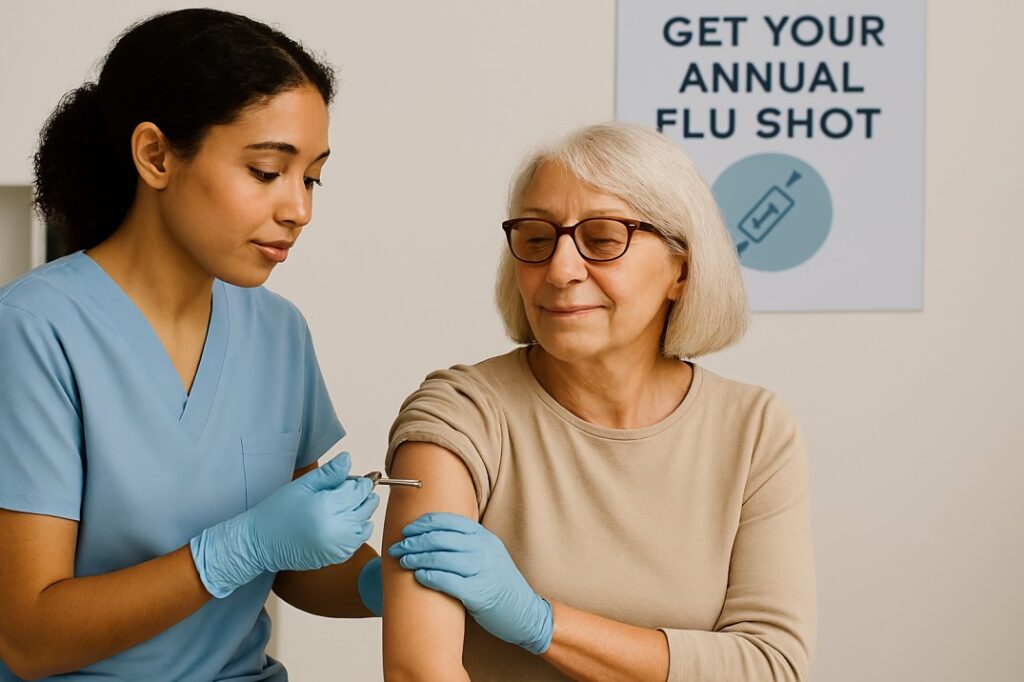
Who should get it: Everyone, every year. For adults 65+, CDC prefers one of these: high-dose inactivated (HD-IIV3), adjuvanted inactivated (aIIV3), or recombinant (RIV3). If none is available, any age-appropriate flu vaccine is fine. CDC
When to get it: Aim for early September through October, but later is still useful if flu is circulating. Immunity wanes, so “just in time” each season is ideal. Influenza Defense
Why it matters: Flu triggers serious complications in older adults, including pneumonia and heart events. The higher-dose or adjuvanted options boost immune response in people 65+. NFID
Common reactions: Sore arm, fatigue, mild fever. These usually resolve in 1–3 days.
Can it be combined with other shots? Yes. You can receive the flu and COVID-19 vaccines at the same visit if timing aligns. Expect slightly higher rates of short-lived symptoms when coadministered. CDC
2) COVID-19: stay current with updated doses
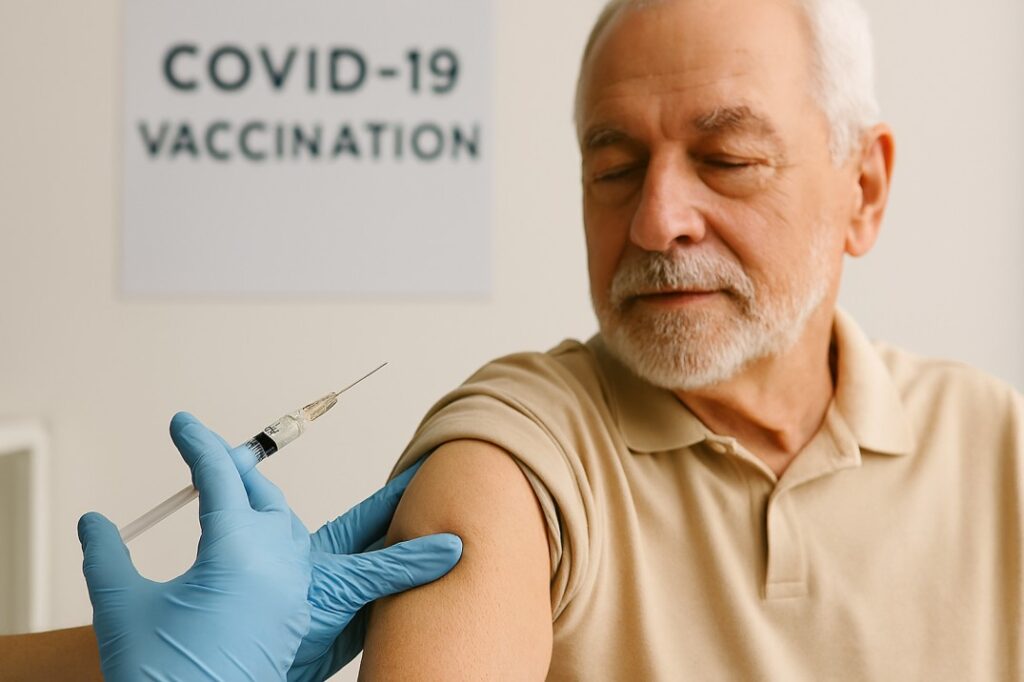
Who should get it: Follow the latest season’s formulation. For 2024–2025, ACIP recommended an additional dose for adults 65+ beyond the base seasonal dose; future seasons may update this cadence, so confirm what’s current when you book. CDC
When to get it: As soon as the current-season shot is available and you’re due. Space additional doses as advised that year.
Why it matters: Age is the strongest risk factor for severe COVID-19, hospitalization, and long-COVID. Updated vaccines are tuned to circulating variants and refresh waning protection.
Common reactions: Sore arm, tiredness, headache, chills, usually mild and brief.
With other shots? Yes—coadministration with flu vaccine is allowed if you’re eligible for both that day. CDC
3) Pneumococcal (pneumonia): critical against lung and blood infections
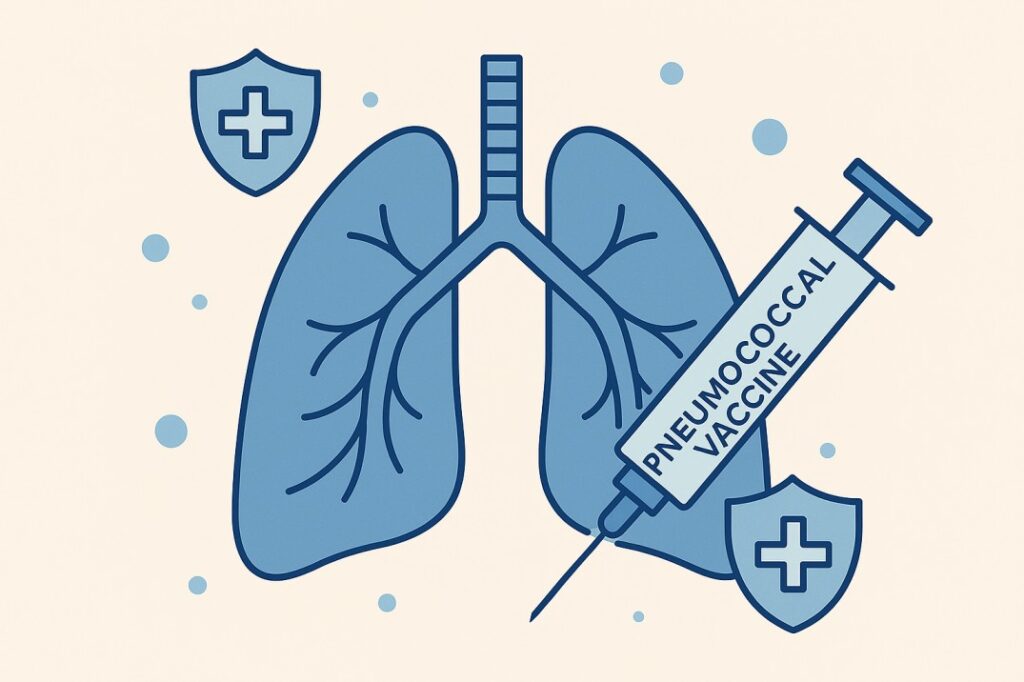
Who should get it: Adults who haven’t had a pneumococcal conjugate vaccine should receive one of the following options: PCV21 (Capvaxive), PCV20 (Prevnar 20), or PCV15 (Vaxneuvance). If PCV15 is used, it should be followed by PPSV23 (polysaccharide) one year later. CDC now recommends pneumococcal vaccination beginning at age 50+, with strong emphasis at 65+. CDC
When to get it: As soon as you’re eligible and have not previously received a conjugate pneumococcal vaccine.
Why it matters: Pneumococcus can cause pneumonia, bloodstream infections, and meningitis—often severe in older adults. Conjugate vaccines broaden coverage and improve immune responses.
Common reactions: Soreness, mild fever, fatigue.
Tip: Bring your vaccine history; your clinician will choose the best single-visit option and determine if PPSV23 is needed later. CDC
4) Shingles (Zoster): prevent a painful rash and nerve pain
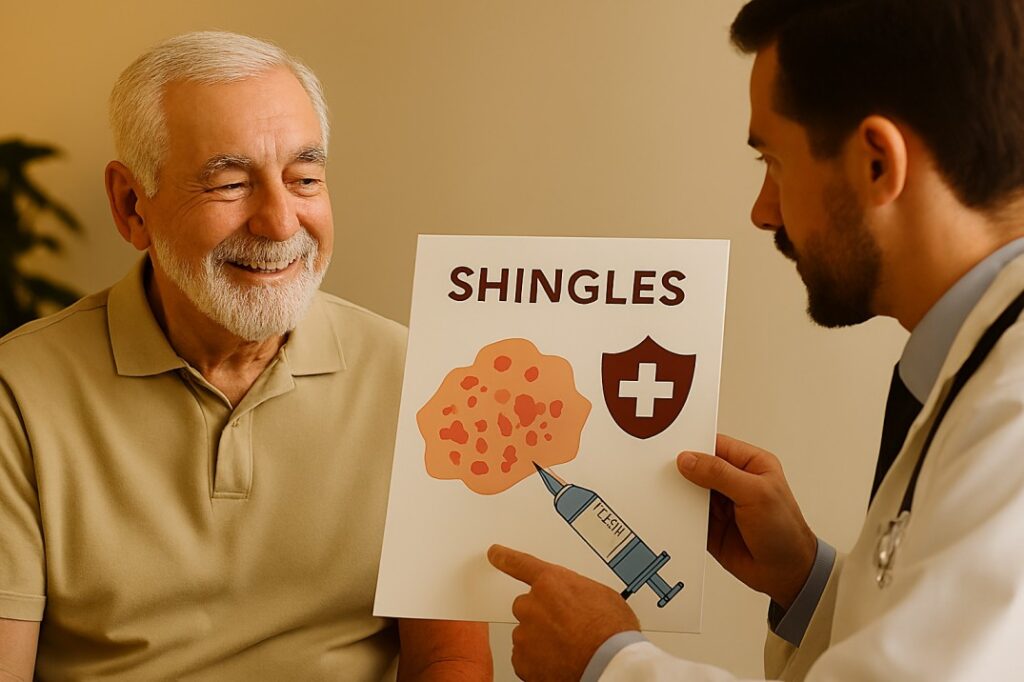
Who should get it: Adults 50+ should receive two doses of recombinant zoster vaccine (RZV, Shingrix), spaced 2–6 months apart, whether or not they recall a prior shingles episode or past zoster vaccination. CDC
Why it matters: Shingles risk rises with age and can lead to months (or longer) of nerve pain (post-herpetic neuralgia). The two-dose RZV schedule markedly lowers that risk.
Common reactions: Sore arm, fever, fatigue, muscle aches for 1–3 days. These are common and a sign your immune system is responding.
With other shots? CDC allows coadministration of recombinant/adjuvanted adult vaccines at different anatomic sites, including with COVID-19 and adjuvanted flu vaccines; expect additive but short-lived side effects. CDC
5) Tdap/Td: keep up protection against tetanus, diphtheria, and pertussis
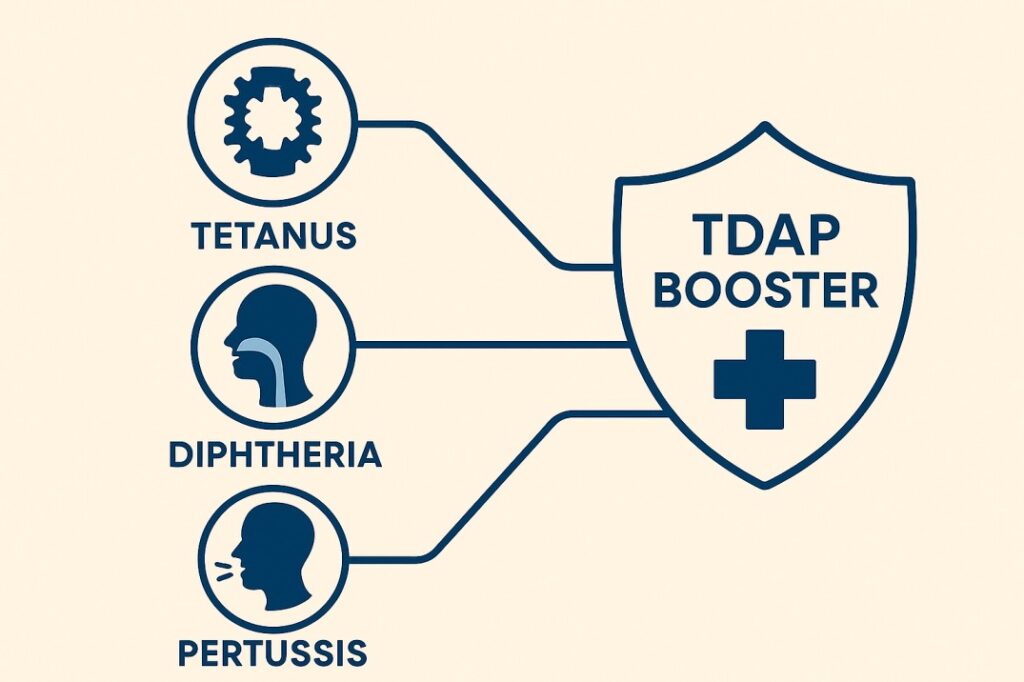
Who should get it: If you’ve never had Tdap as an adult, get one dose now to cover whooping cough (pertussis). After that, get a TD or Tdap booster every 10 years for life. CDC
Why it matters: Tetanus lives in the environment and can be deadly. Diphtheria still appears in outbreaks. Pertussis circulates and can be severe for you and the people around you.
Wound tip: For certain dirty wounds, an early booster may be recommended if it has been more than 5 years since your last tetanus-containing shot. Your clinician can advise. CDC
6) RSV (Respiratory Syncytial Virus): one-time dose for many older adults

Who should get it (2025): CDC recommends a single dose of an age-appropriate RSV vaccine for all adults 75+ and for adults 50–74 who have conditions that raise the risk of severe RSV (for example, chronic heart or lung disease, diabetes with complications, advanced kidney disease, or significant frailty). It is not an annual vaccine at this time. CDC
Why it matters: RSV can cause serious lower respiratory infections in older adults and drive hospitalizations in peak season.
Common reactions: Sore arm, tiredness, headache, muscle aches.
Planning tips: make scheduling easier
- Bundle smartly. It’s convenient to receive flu and COVID-19 at the same visit when you’re due for both. You can also receive other adult vaccines at the same appointment at different injection sites. Expect more local soreness if you combine shots. CDC
- Track your history. Keep a list or photo of your vaccination card(s). Bring them to every appointment.
- Time flu seasonally. September–October is ideal for most older adults; later is still worthwhile if the flu is circulating. Influenza Defense
- Mind intervals. Shingles needs two doses 2–6 months apart; PCV15 requires PPSV23 about a year later. Set reminders so you finish the series on time. CDC
- Ask about coverage. In some countries (e.g., the U.S.), Medicare and many insurers cover ACIP-recommended adult vaccines at no cost when in-network. Check your local program and pharmacy. Kiplinger
The best vaccines for people 60 and older at a glance
- Flu: yearly; prefer HD-IIV3, aIIV3, or RIV3 at 65+. CDC
- COVID-19: stay current with seasonal guidance; adults 65+ were advised an additional 2024–25 dose. CDC
- Pneumococcal: one-visit options now include PCV21 or PCV20, or PCV15, then PPSV23 later. CDC
- Shingles (RZV): two doses, 2–6 months apart, starting at 50+. CDC
- Tdap/Td: one adult Tdap, then Td/Tdap booster every 10 years. CDC
- RSV: one-time dose for all 75+ and for 50–74 at increased risk; not annual. CDC
How to sequence vaccines for people 60 and older
- Start with what’s due now. If it’s fall, book flu (and COVID-19 if you’re due).
- Catch up your base layer. If you’ve never had Tdap as an adult, get it; then set your 10-year booster reminder. CDC
- Close pneumococcal gaps. If you’re 65+ and PCV-naïve, one conjugate dose (PCV21 or PCV20) can often finish your series in a single visit. If PCV15 is used, schedule PPSV23 in ~12 months. CDC
- Add shingles. Dose 1 today; book Dose 2 at 2–6 months. CDC
- Consider RSV. If you’re 75+ or 50–74 with higher risk, a one-time dose can be given any time of year. CDC
Side effects: what’s normal and what’s not
- Expected: Sore arm, fatigue, headache, mild fever, muscle aches—typically 1–3 days.
- Less common: Swelling, redness, and short feverish spells.
- Seek care urgently: Trouble breathing, hives, facial swelling, chest pain, sudden confusion, or any symptom that feels severe or unusual.
If you’re immunocompromised, on blood thinners, or recovering from illness, ask your clinician how to time doses safely with your therapies.
FAQs
1) Can I get more than one vaccine on the same day?
Yes. Many adult vaccines can be given at the same visit at different injection sites. Flu and COVID-19 can be coadministered if you’re due for both. Your clinician will advise the best plan for you. CDC
2) Is the RSV vaccine yearly?
No. Right now, the CDC recommends a single dose for most eligible older adults; it’s not an annual shot at this time. If you have already received an RSV vaccine before these updates, you don’t need another one currently. CDC
3) I had pneumonia years ago—do I still need a pneumococcal shot?
Likely yes, if you haven’t received the recommended conjugate vaccine(s). Adults 50+—and especially those 65+—should receive PCV21, PCV20, or PCV15 (with PPSV23 later if PCV15 is used). Your records will guide the choice. CDC
4) I had shingles once. Do I still need Shingrix?
Yes. Two doses are recommended for all adults 50+, regardless of prior shingles or older zoster vaccines. CDC
5) I got a tetanus shot a few years ago. Do I still need Tdap?
If you’ve never had Tdap as an adult, you should get one dose now, even if you recently had a tetanus shot. After that, Td or Tdap every 10 years. CDC
6) Can these vaccines worsen my chronic conditions?
Vaccines are designed to prevent complications from infections that worsen chronic conditions. Most people tolerate them well. If you’ve had prior severe allergic reactions or special medical therapy, discuss timing and the observation period after shots with your clinician.
7) Are these vaccines free?
Coverage varies by country and plan. In the U.S., Medicare and many private insurers cover ACIP-recommended adult vaccines with no out-of-pocket costs when you use in-network providers. Check your benefits or the local health department. Kiplinger
Quick checklist for your next appointment
- Bring your vaccine card(s) or a list of past shots
- Ask which single-visit pneumococcal option fits you best (PCV21 or PCV20 vs PCV15→PPSV23) CDC
- Book Shingrix Dose 2 before you leave (2–6 months) CDC
- Confirm you’ve had one adult Tdap; if not, get it today and set your 10-year reminder CDC
- If 75+ (or 50–74 with high-risk conditions), discuss RSV one-time vaccination CDC
- If it’s fall, get your flu shot; consider coadministering with COVID-19 if you’re due for both CDC+1
Note: If you found these tips helpful, share this article with friends and family. For more science-backed health insights, explore our latest blogs on Nowspress.
